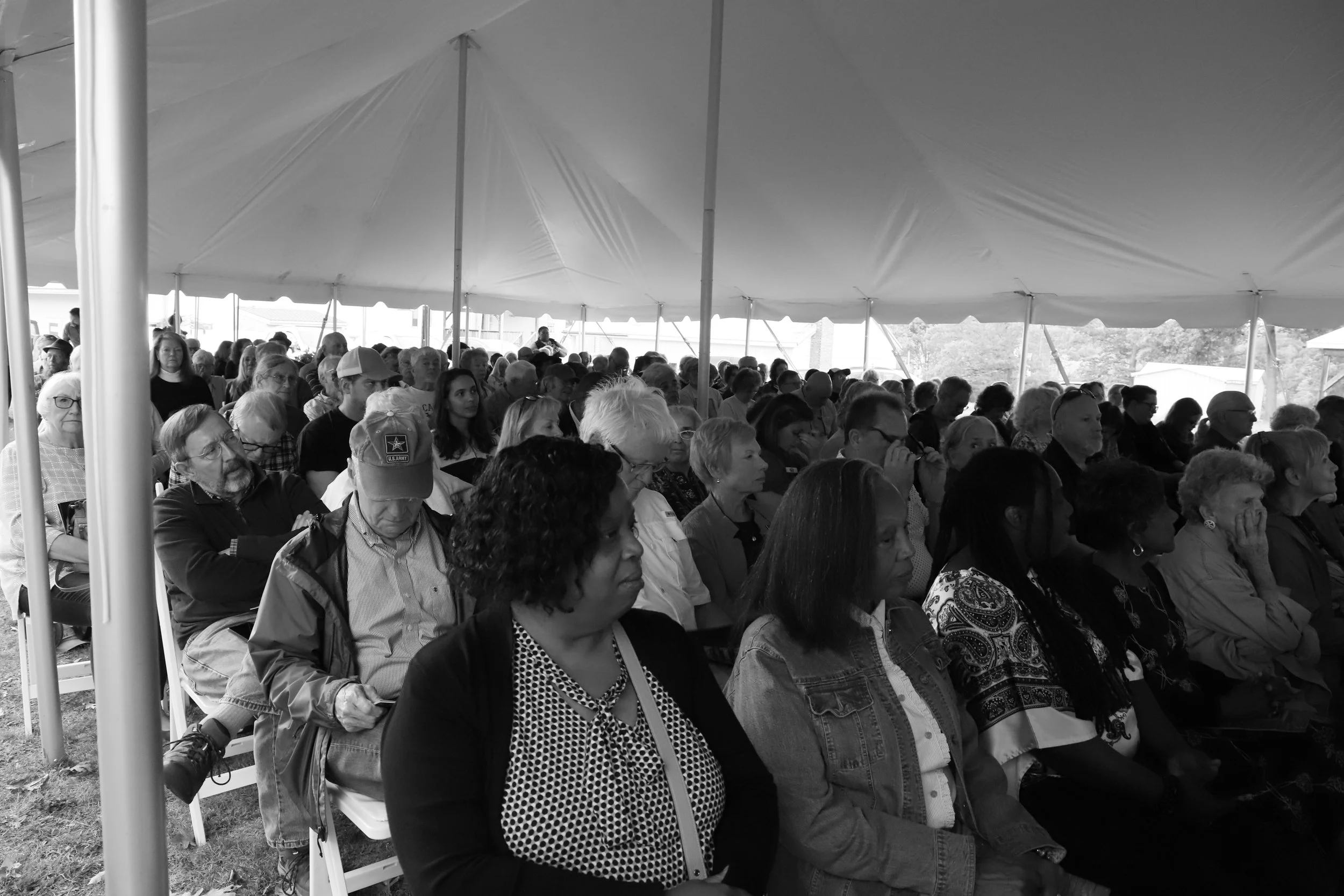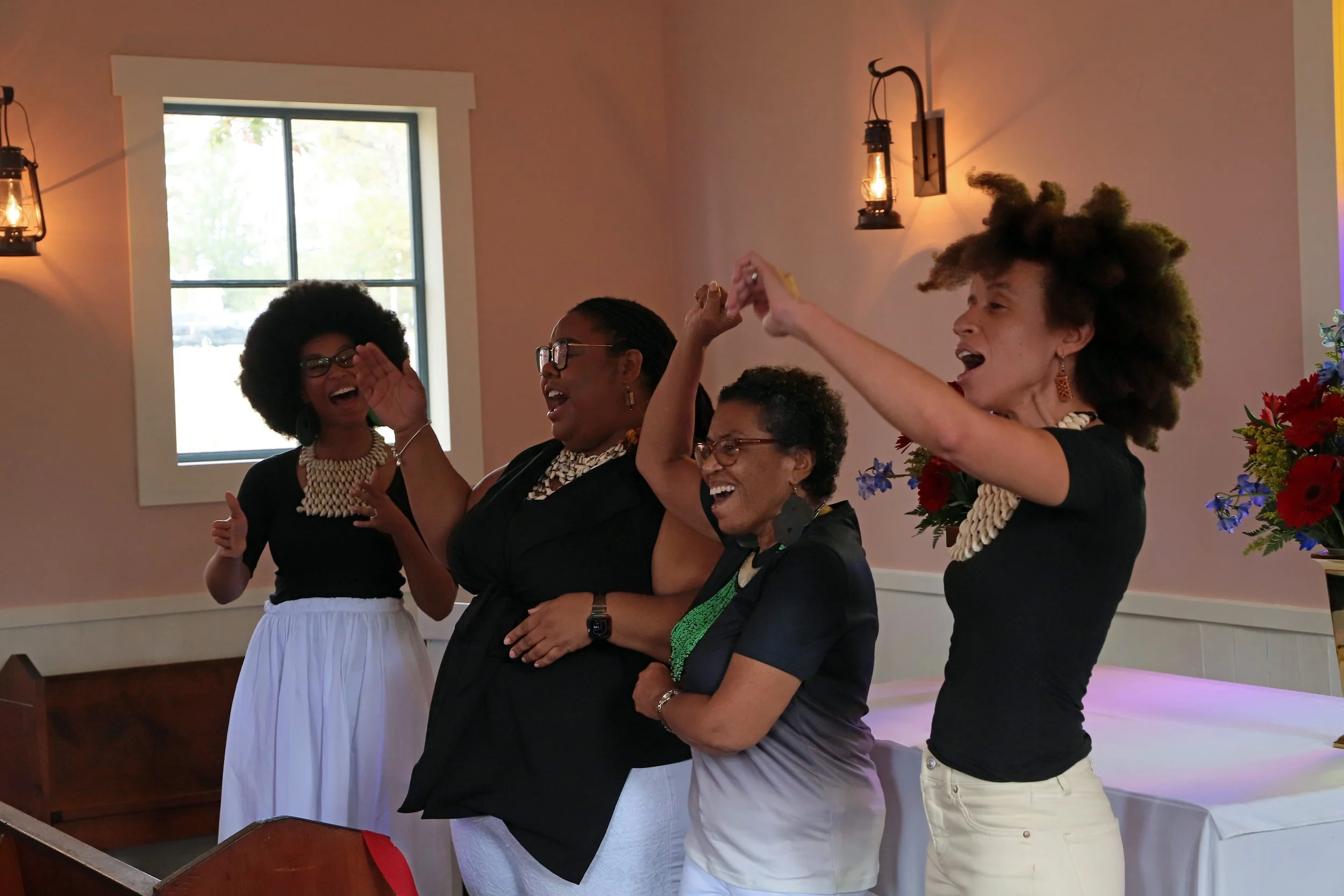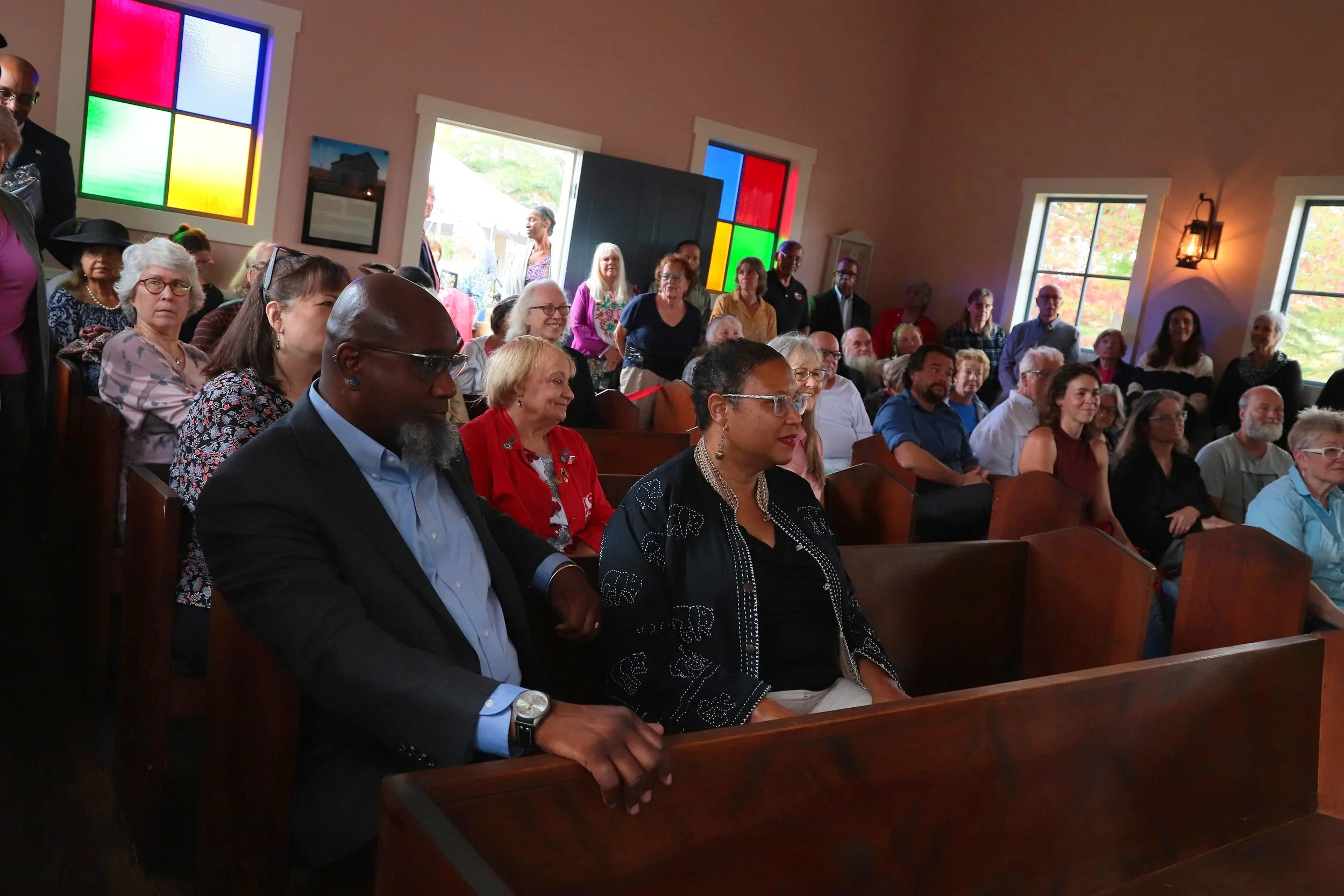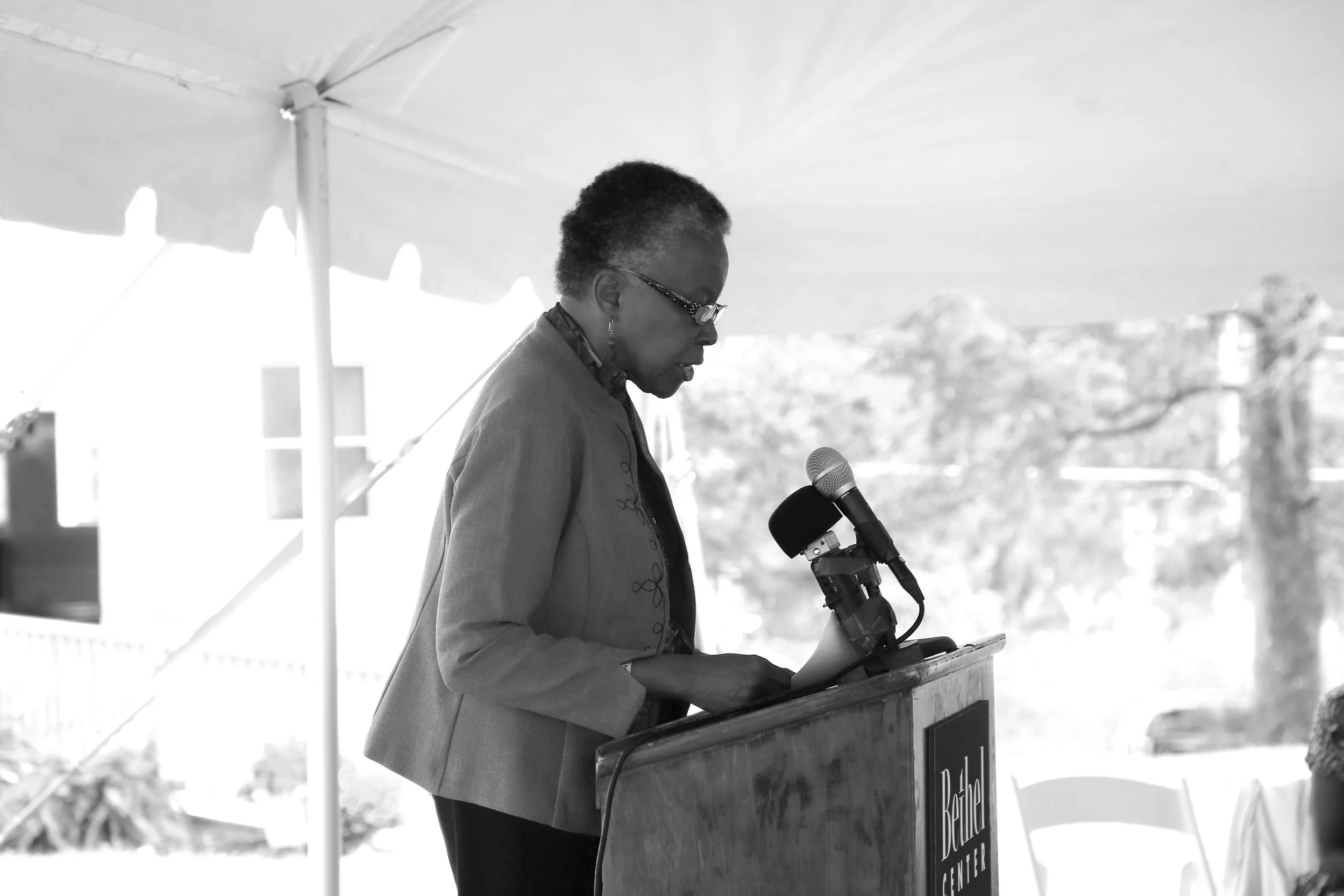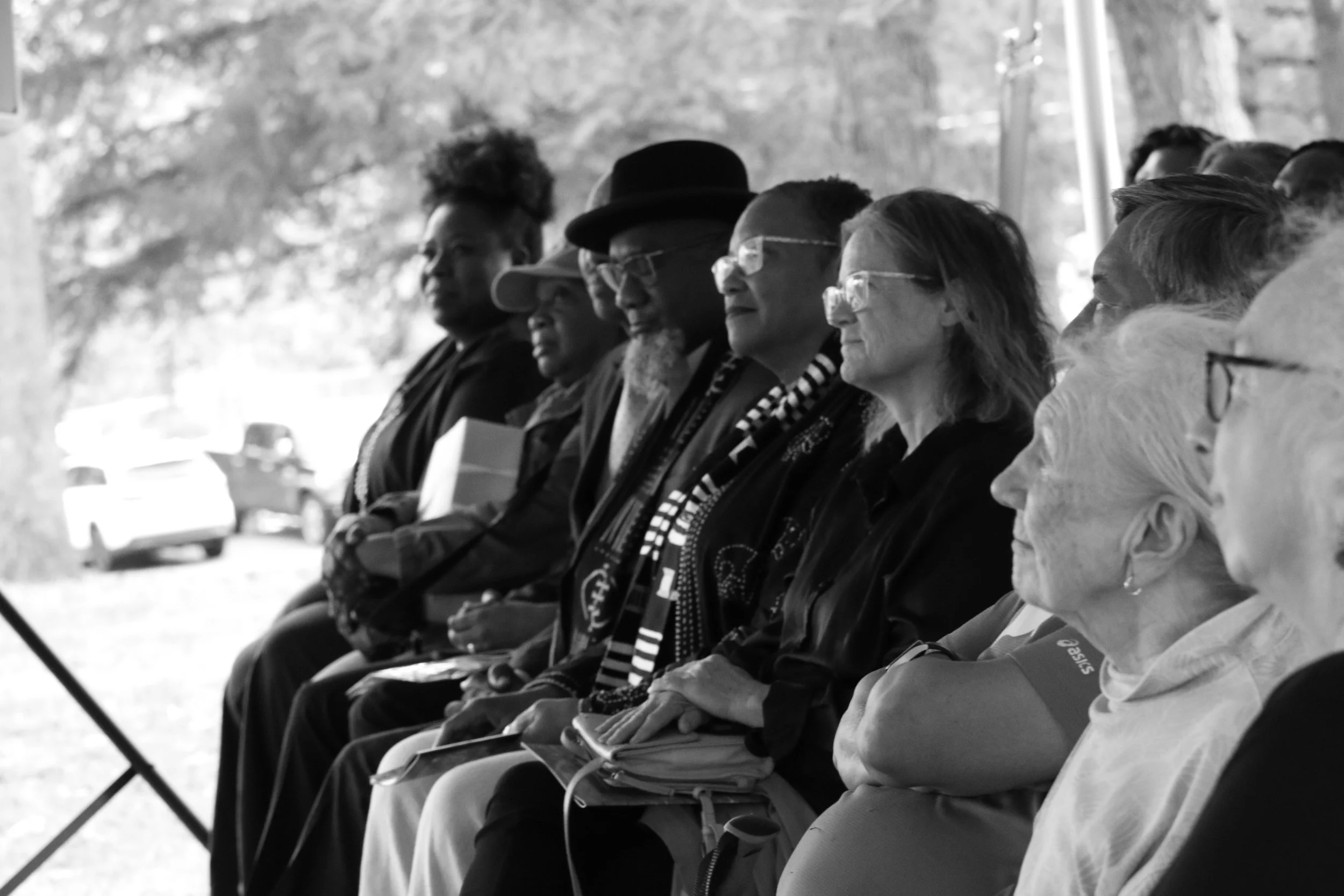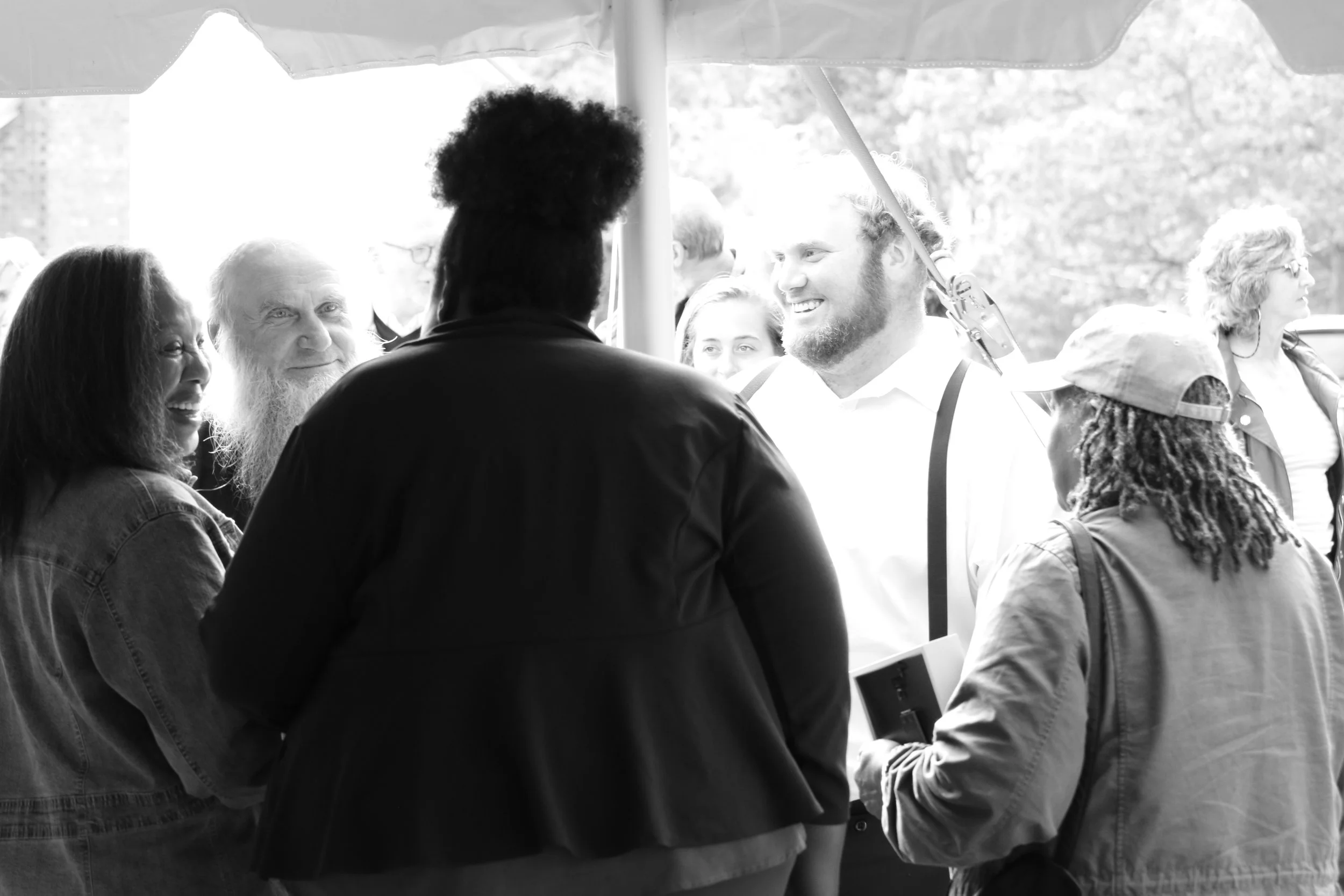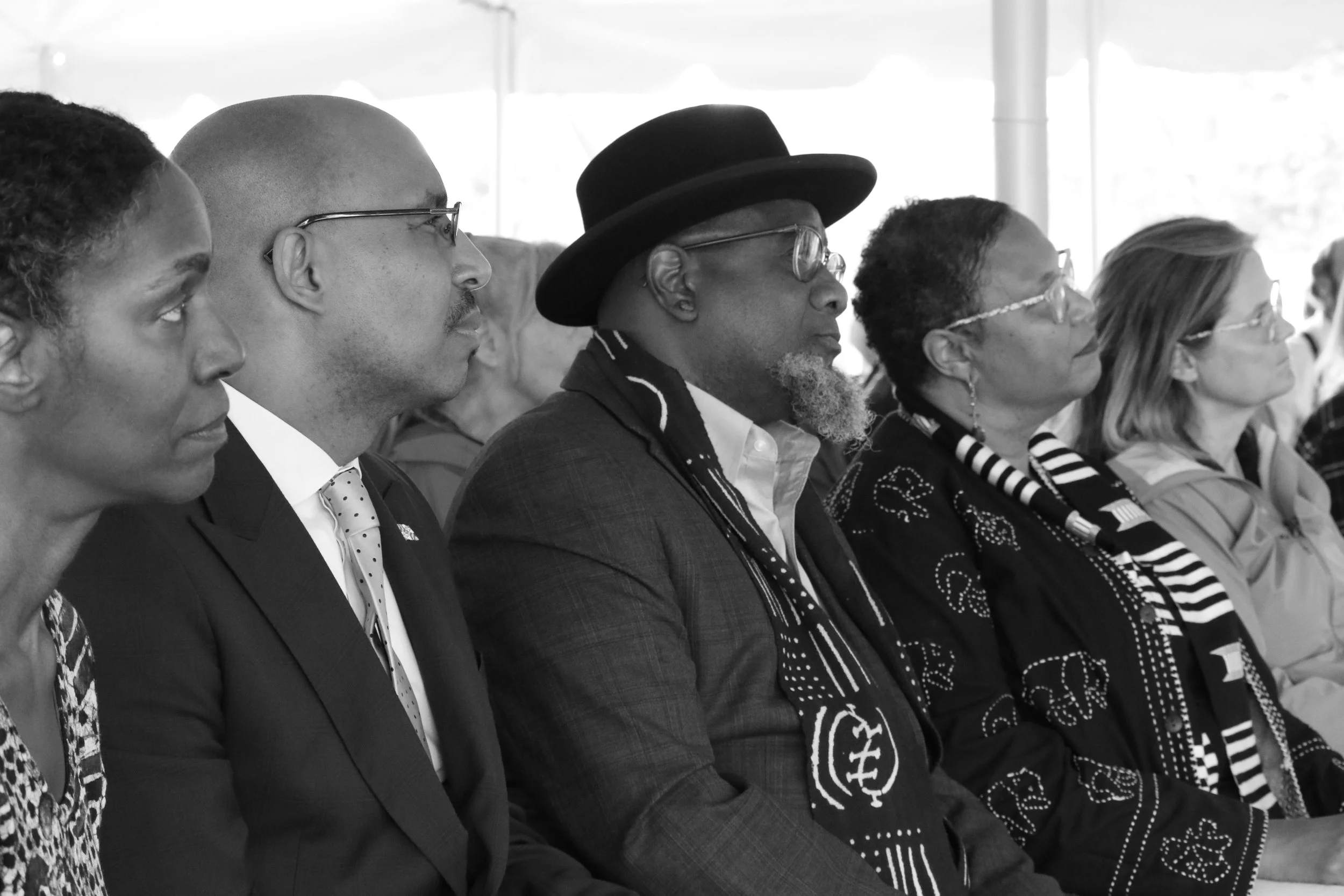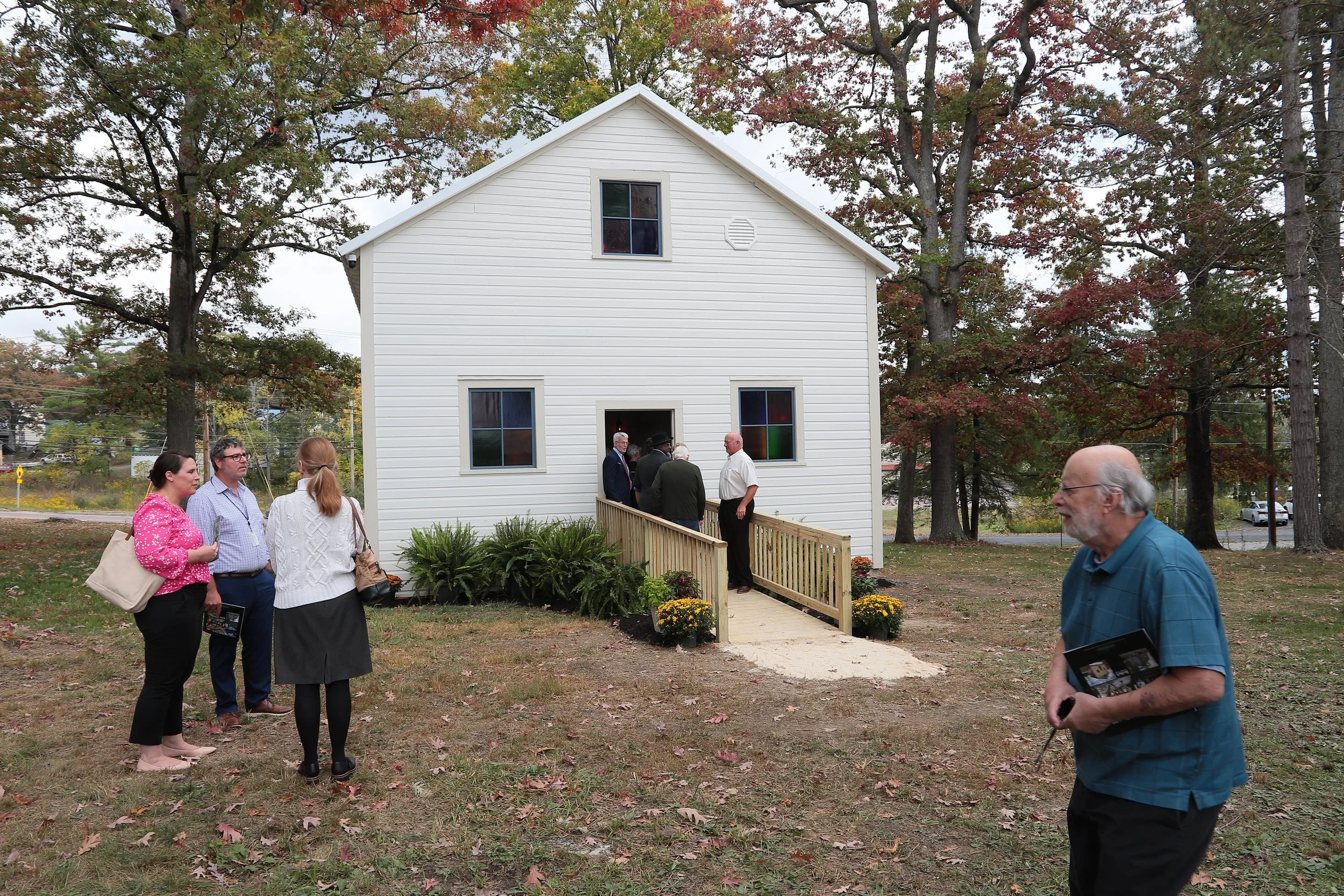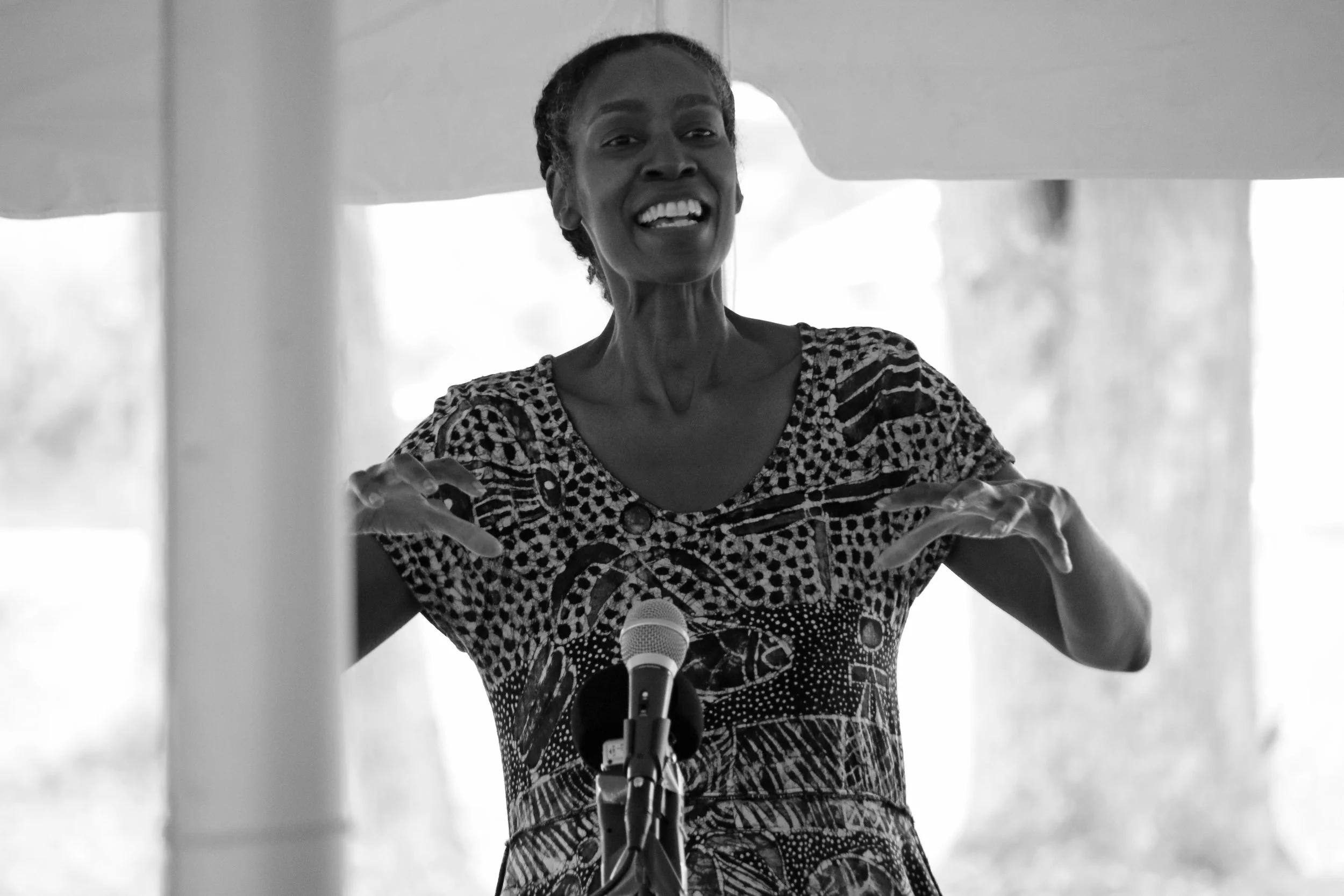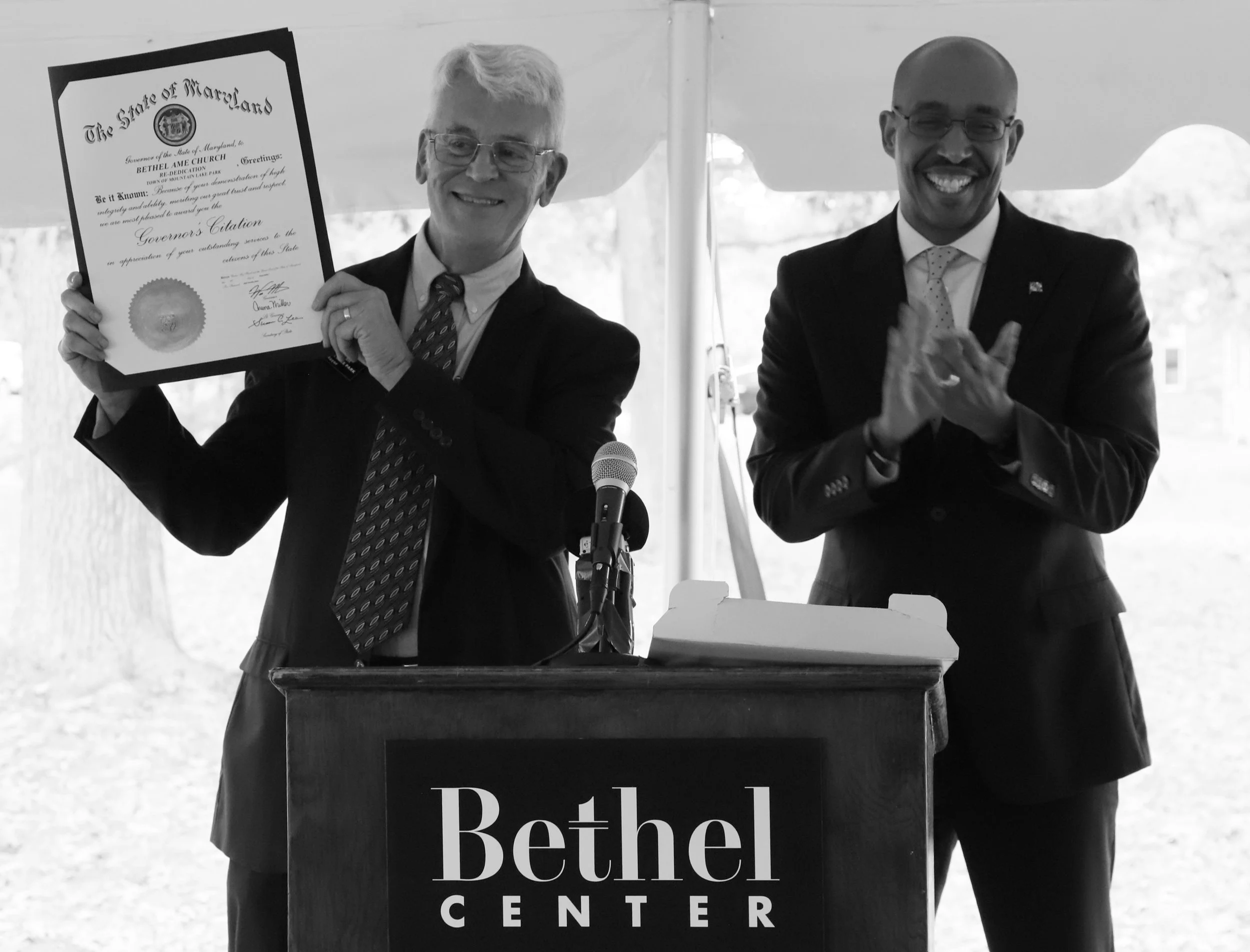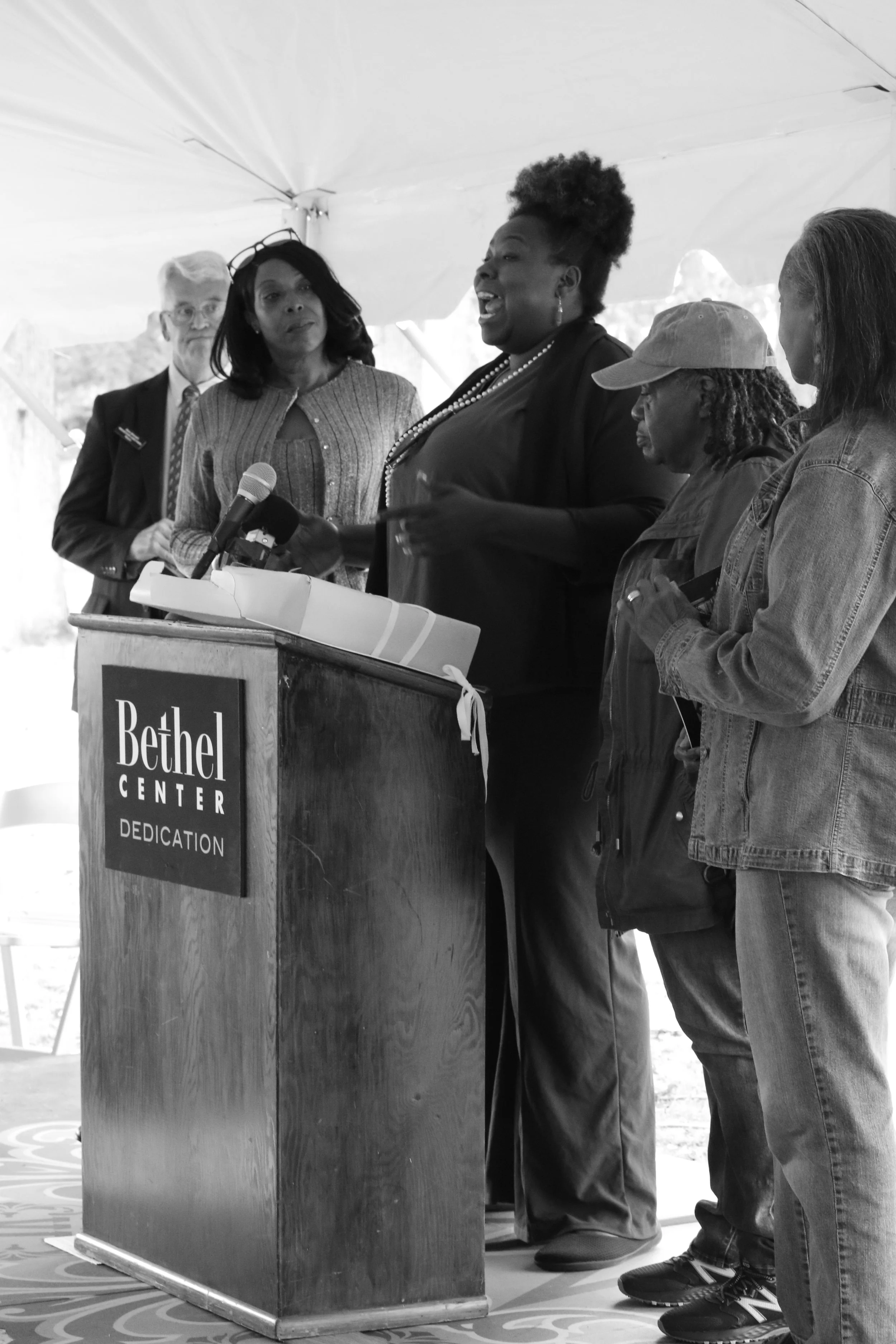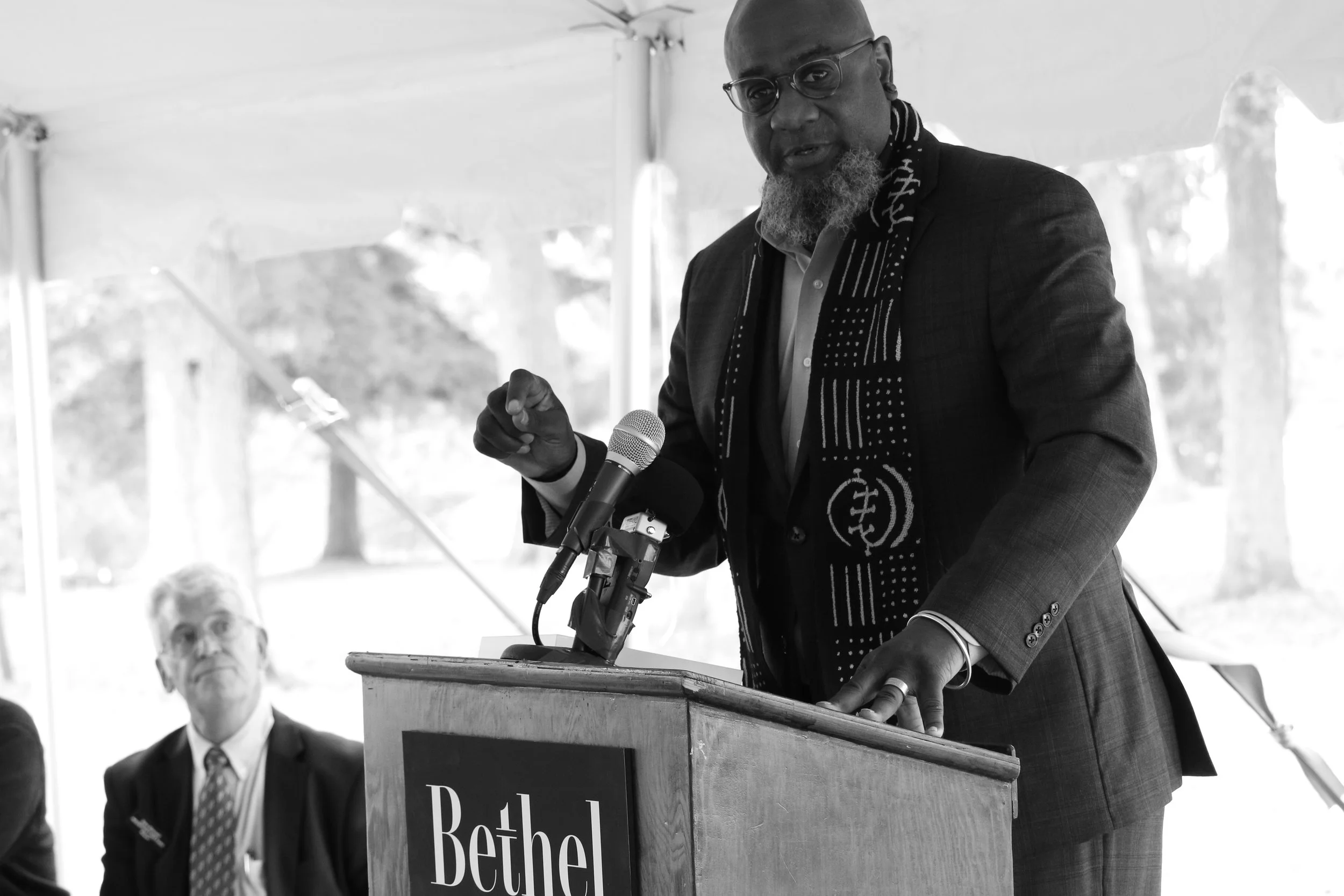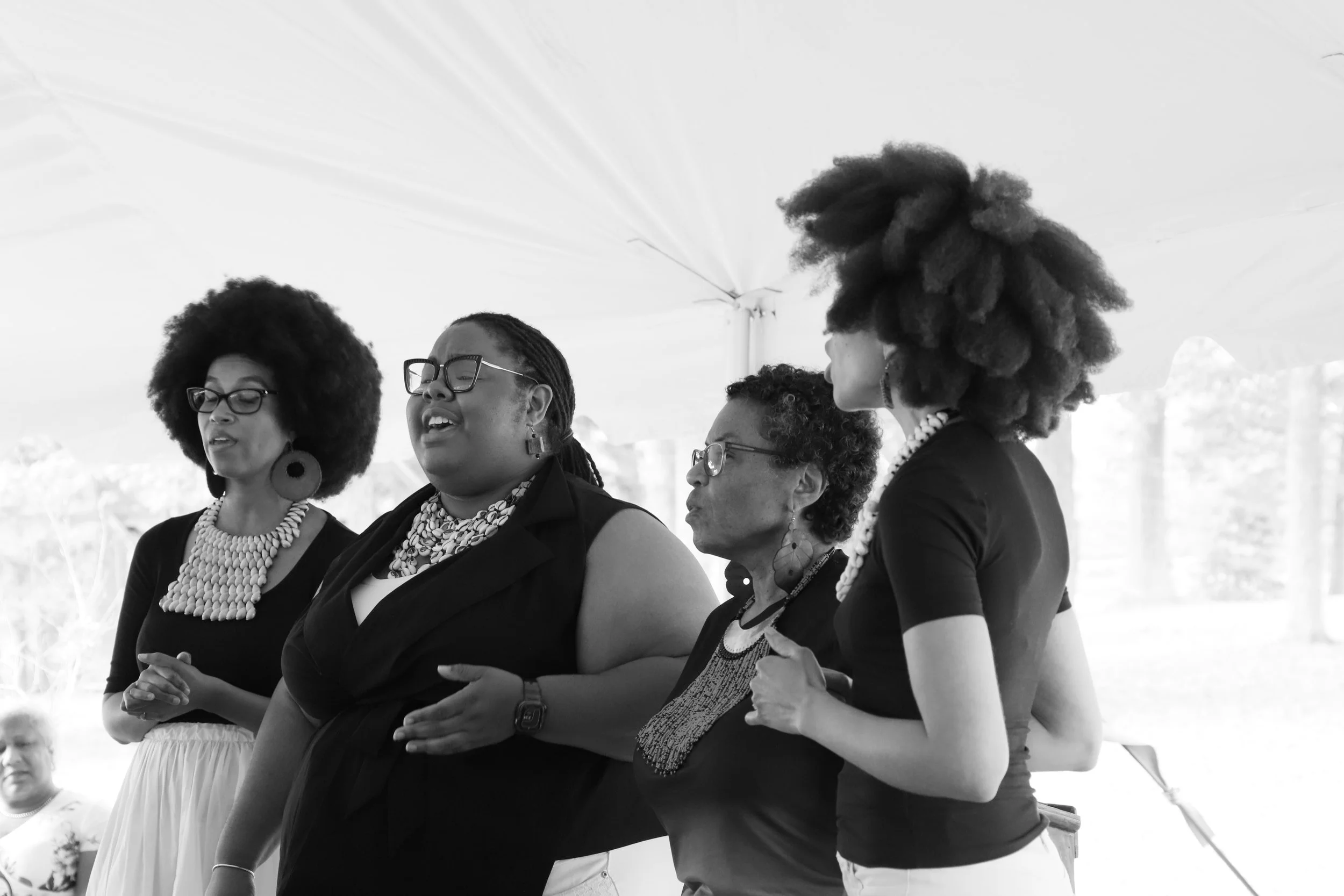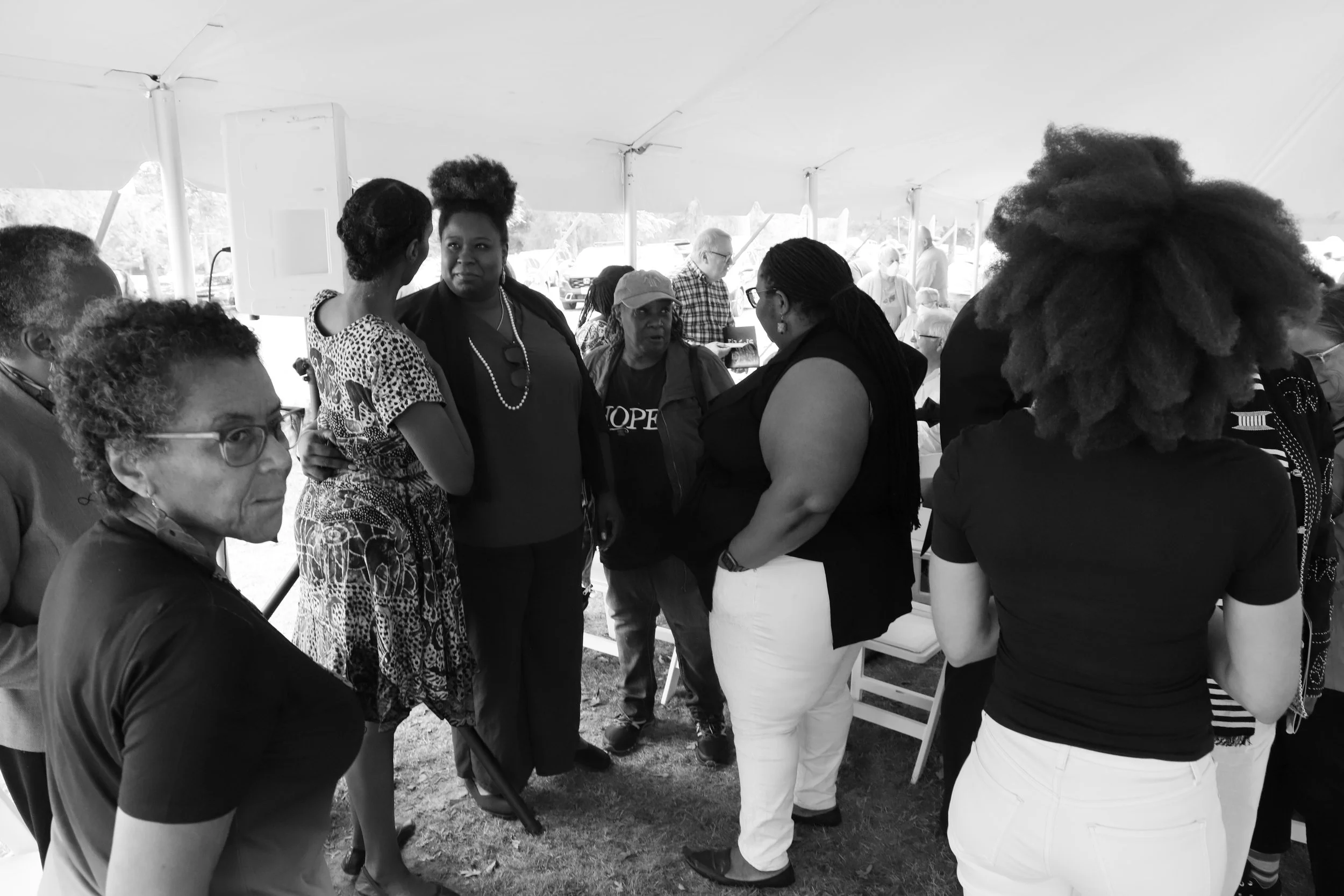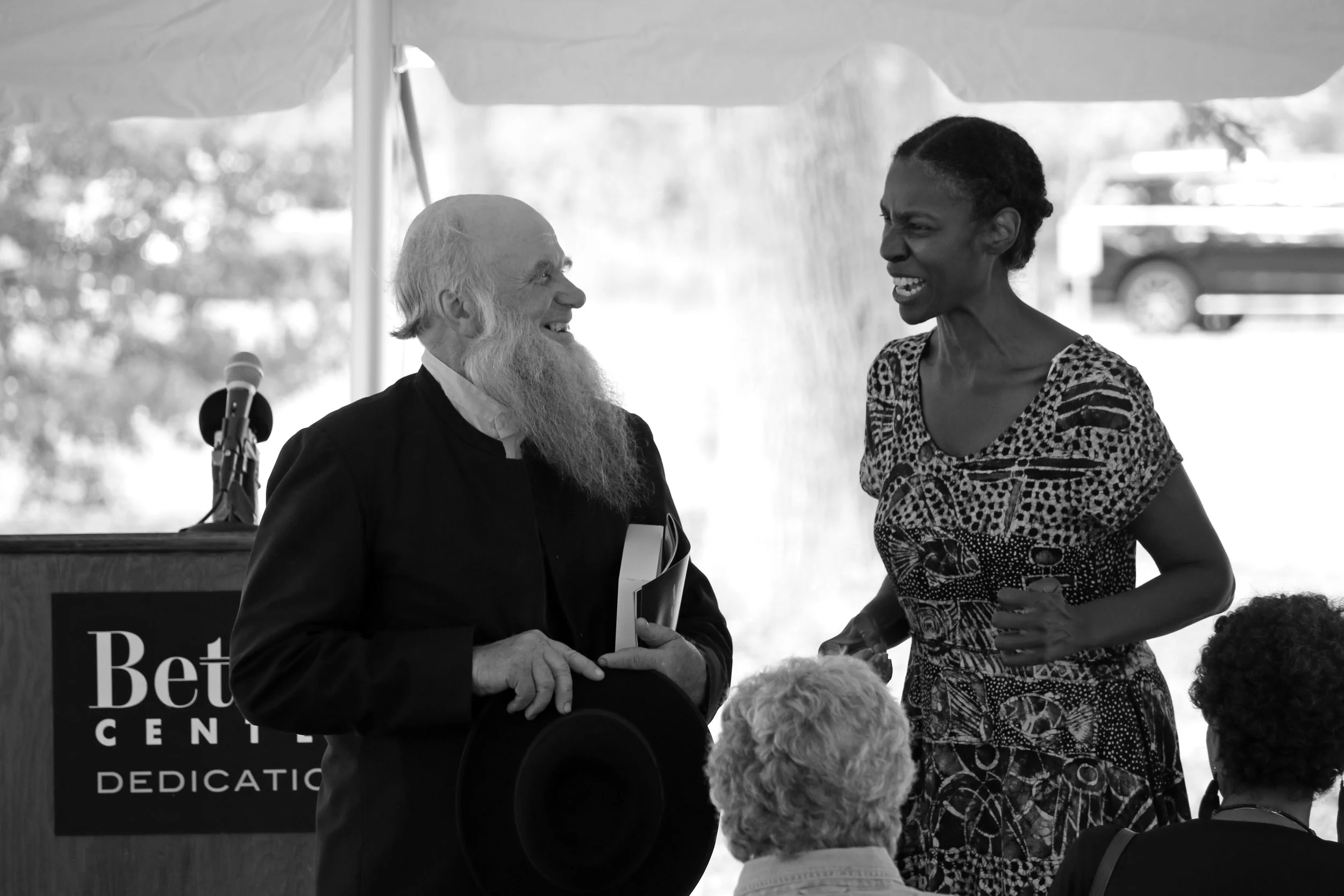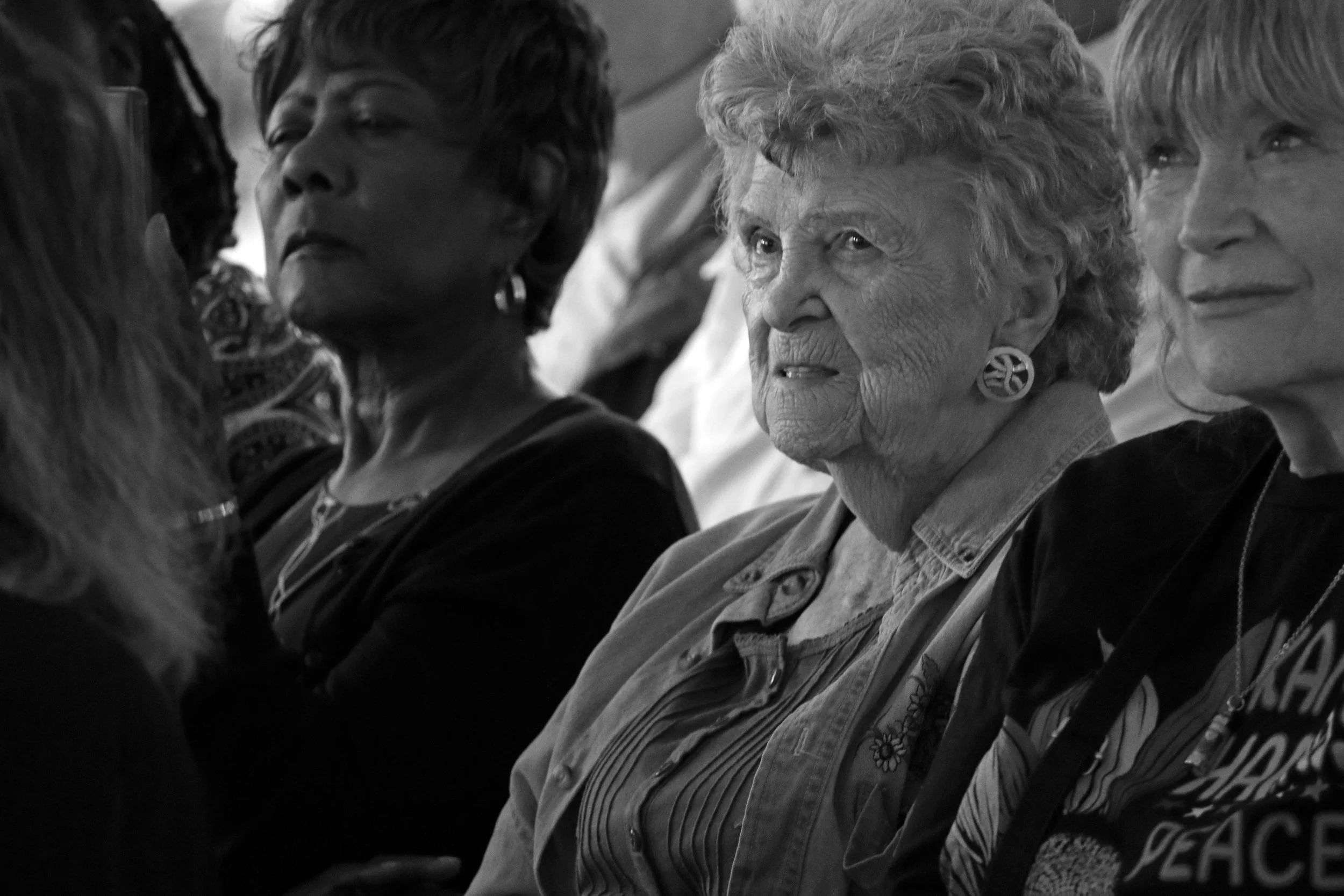A Healing Dedication
Over 200 people gather to celebrate the rededication of Bethel Center. Photos courtesy of Laura Stutzman, Eloqui, Inc.
After a months-long dry spell in Garrett County, Maryland, forecasts for rain landed squarely on the much-anticipated dedication day of Bethel Center. A day that would bring together speakers and presenters from across the state to celebrate the restoration of Garrett County’s only “colored” church.
Originally called The Bethel African Methodist Episcopal Church, Bishop Benjamin Lee first dedicated the historic structure on September 23, 1900, at three o'clock in the afternoon. The church opened its door to a growing African American congregation who met in homes and community buildings in years prior. Under the spiritual guidance of Reverend William Walker, worshipers invested four years to raise the funds needed to build a sanctuary of their own. After a century-long journey of relocations and alternate uses, the A.M.E. Church found a permanent and prominent home in the Historic District of Mountain Lake Park that honors the African Americans who were an interwoven part of Garrett County and Maryland's history.
As weather predictions often do on the mountaintop, threats of rain changed daily and hour by hour leading up to when the program was set to begin. On the morning of the dedication, the heavens opened up, pouring down torrential rains, pounding the large tent prepared as shelter for two hundred guests, clinking off the new tin roof of the restored church standing nearby, and pummeling dried leaves loose from the canopy above. Under a heavy cloud of darkness, it appeared God chose to wash away best-laid plans at this early hour. And as if an act of mercy, the sky brightened, the rains subsided, and the Almighty restored peace and tranquility under the grove of towering trees. The thirsty landscape became replenished as if nature acted out a dramatic prelude to the celebration ahead.
The parched ground drank up the puddles, allowing volunteers to set up chairs and tables and organize the tasks at hand. Seating quickly filled as guests arrived for the historic occasion. The crisply painted church, surrounded by ferns and flowering plants on loan from neighborhood porches and patios, drew people toward it. A conventional Sunday spirit was palpable that Monday morning.
Inside Bethel Center, rows of pews aligned like soldiers guarded a bright red carpet runner, leading to the alter draped in pressed white linens, adorned with a glistening gold cross and flower arrangments of blue snapdragons and deep red blooms opened wide. Behind the altar, light streamed through four panes of colored glass, yellow, red, blue, and green, indicative of traditional A.M.E. churches, intersecting as a vibrant rainbow filling the room. A pump organ sat in repose as it made way for the women's vocal quartet, HALO, who were invited to perform traditional spiritual songs, and oh, did they.
HALO Quartet presents the first spirituals inside Bethel Center.
Sisters Shana Oshiro and Niambi Powell gathered at the front of the church with their mother, Allyn Lloyd, and lead vocalist, Portia Pitts. They are dressed in coordinated black, white, and cream colors with beaded shells around their necks that provide textural opulence and percussive sounds when tapped. The notable ensemble is recognized as the first quartet of American-American singers to compete on the international contest stage of any of the major barbershop organizations.
A hush came over the room as the ensemble softly sang their first a cappella number. Their syncopated harmonies melted together, captivating the audience, who sometimes moaned, swayed, clapped, or stood with encouragement and approval. The absence of instrumental accompaniment allowed their voices to shine and fill the space that once held a devout A.M.E. congregation. From moving and emotional to upbeat and lively, the HALO Quartet ended their set with a tribute song for Kate Smith, who is credited with inspiring the church's rebirth.
A nourished audience listens in awe.
The performance ended, leading people outside to the large tent filled with anxious onlookers. Mayor Don Sincell took to the podium, welcoming everyone on a day he had anticipated since he and his town council passed a motion to acquire the A.M.E. church two years earlier. Reverend Phyllis Anderson, a Garrett County resident, was introduced to deliver an opening prayer.
"We establish this place for prayer. We establish this place for transformation," Phyllis said calmly and gently. "We ask in the presence of our celestial ancestors and the angels you have assigned to this place, that attend to it day and night – those who have watched over this place from the time of its founding to the time of its moving, to the time of its reclamation – In the presence of those ancestors and angels we ask oh God that you would pour out a blessing."
Her words reminded those in attendance that the church always remained a holy and sacred place through its various stages of condition, use, or location.
Mayor Sincell followed the reverend with the story of how and why Mountain Lake Park became the new home for the A.M.E. church.
"It was on this day, one hundred and twenty-four years ago, that the Bethel African Methodist Episcopal Church was dedicated at the corner of Fifth and High streets in our neighboring town of Oakland," said the mayor. He described the church as more than a place of worship. It was a sanctuary and a school, and it became a centerpiece for over 300 African American residents who helped the railroad towns of Oakland, Mountain Lake Park, Loch Lynn Heights, and Deer Park to flourish.
The local Amish community supplied refreshments for the dedication ceremony at the back of the sixty-foot-long tent. Their contribution goes well beyond cookies and lemonade. In its second life, the old A.M.E. Church was part of their community's landscape for many decades. Mayor Sincell described the winding history of the church.
"With the closing of the big resort hotels during the 1920s, the approaching depression, and yes, incidents of racism that they experienced while living here, they migrated from Garrett County," Sincell explains of African Americans who vanished from the community they helped to build.
After the A.M.E. congregation dwindled and the church sat empty, Simon Swartzentruber, an Amish farmer, relocated the unused building in 1935 to his property roughly six miles outside of Oakland to Pleasant Valley, where it served as a harness and carriage shop for over eighty years. Simon and his family became part of a national story when they were featured in a 1970s exposé on Amish life for National Geographic. Simon is photographed engulfed in sparks as he hammers a weld inside his former church shop. As Simon aged, he left the farm to his grandson, Samuel Yoder. Over time, the shop building eventually suffered the ravages of aging, requiring more restoration than Samuel could justify investing in, yet preserving the building that was once a church remained a mandate from his grandfather, one Samuel would come to honor and pursue.
Poet, playwright, and author Marcia Cole reads an original poem she created about the Bethel A.M.E. Church.
An engaged audience learns about the A.M.E. Church journey.
Tifani Fisher reunites with the Yoder family.
Poet, playwright, and author Marcia Cole tapped into that narrative when asked to write a commemorative poem about the church's history. Her words rang true, drawing metaphors between the trials of African Americans in the early twentieth century and a craftsman toiling at his forge.
"Men, like metal, are forged under stress," she said, "going through the testing fires wrought by the hammering blows of life to be changed into something new."
She cleverly captured the essence of the simple but sacred structure that served a grander purpose throughout its multiple uses.
"Bethel Center is more than wood and stained glass," said Devin Barroga, who serves as president of the Garrett County NAACP, the last county in Maryland to build a chapter. He addressed the importance of saving more than the physical building.
"It is a symbol of perseverance, resilience, and community. It is a testament to those who came before us. Those who found strength in the face of adversity and those who believed progress is built one generation at a time. It stands as a beacon of hope, reminding us of the work that remains. Our history – Garrett County's history is rich with stories of struggle and triumph," said Devin. And with further optimism, he added, "We must also look forward. Bethel Center, like our community, is not just a relic of the past. It is a space where the dreams of tomorrow can take shape. It's where we can come together not just to reflect but to educate, inspire, and create the future we envision. A future of equality, justice, and opportunity for all."
Speaker Kate Smith stands behind Sheila Coleman and Garrett County NAACP President Devin Barroga.
Sheila Coleman Castells from West Virginia told the audience she first met Kate Smith at Walmart, drawing a big laugh. "All roads in Garrett County lead to Walmart," she humorously added.
As a long-time friend and mentor, Sheila was asked to introduce Kate as someone who probably knew her best. With a background in community service, education, and politics, she dispensed sound advice for Kate as a new county resident.
"We have all contributed to this country. And indeed, as African Americans, our blood, sweat, and tears are here in this land, right next to all of your ancestors, too,” Shelia reminded an audience of predominantly White people. “We have a right to be here, and here we will stay."
Sheila shared that the ancestors who built the A.M.E. Church “cried out until Kate and her colleagues found them and their holy temple, constructed with the sweat of their brow, for the glory of God that sustained them throughout their lives until that church and their livelihoods were wrenched from them because of Jim Crow,” the laws which were a form of racial apartheid that affected nearly every aspect of daily life for African Americans.
Before her introduction of Kate, Sheila reminded everyone that she, and she alone, was the reason the church was saved. Kate’s dedication to researching Garrett County’s African American ancestors unearthed a hidden history.
“She found US,” Sheila said, meaning the Black citizens and worshippers of the church. “She found US on plantations in Garrett County. She found US in slave cemeteries. She found our homes and businesses. She found our Methodist Episcopal Church – Bethel,” Sheila points out the accent on the second syllable of Bethel, which means “house of God” in Hebrew. “We indeed were here, and we are here today.”
"This has been a long time comin'," said Kate as she paused for a long look at the church now restored before her. Near ruin upon her first visit, Kate's last memories of the building were starkly different. She relocated to North Carolina before the restoration work began, relying on progress updates from her friends up north. Kate originally chose Garrett County as her sanctuary to separate from an abusive relationship off the mountain. She found peace and safety in the rural beauty that surrounded her. Upon her arrival, she developed deep and lasting friendships, quickly involving herself in organizations that served the new-found community she called home. But as she looked around, the absence of other Black residents perplexed her, and although people of color were not physically by her side, she felt their presence inside her soul and within the walls of the A.M.E. Church she had just learned about.
Pictured from left to right is storyteller Diane Macklin and speakers Gregory Yancey, Rev. Jonathan C. Anderson, and Rev. Phyllis Anderson.
"There's a church," she said, "and I know there's a church because Albert Feldstein helped me realize that I belonged here." Feldstein, a lauded local historian, directed Kate to research African American history using the whilbr.org online archives, where she discovered a treasure trove of information on former freed and enslaved Africans who went unrecognized as part of the Garrett County story.
"I remember the first time I entered this church when it was just the old blacksmith's barn on Sam Yoder's farm," Kate recalled. "And he asked me if I wanted to pray in this church," a building that was then filled corner to corner with tools, buggy parts, harnesses, gadgets, and machinery. Sam said, "You'll be the first African American in this building since it's been here," something Kate described as a great honor.
Kate did pray, asking God to "get the church back" because “it wasn't yet home,” as she put it. "So when it was time," she said, "I gathered some strong warriors," calling out the names of those she referred to as her "twentieth-century abolitionists," to restore and relocate the building to a place of honor. And so it began.
During the darkness and isolation of the global pandemic, Kate took a deep dive into Garrett County's African American story, looking to resurrect the people who fled in the early 1930s. She combed through census records with the help of her Allegany County friend, Tifani Fisher, a descendant of the Bethel A.M.E. Church congregation. She visited the gravesites of former Black residents, slowly allowing her to piece together lost generations.
Through her journey and desire to serve her newly adopted community, Kate sought a seat on the Oakland Town Council and won, making her the first African American elected official in Oakland. But not every constituent treated her with the respect she deserved. Now, in the public eye, Kate endured verbal attacks fueled by racism and ignorance.
But through it all, she realized her experience in Garrett County "wasn't about hate; it was about love because God turned her struggle into power, and her trauma into resilience."
"He alchemized all of this," she said with conviction. "Not just for me, but for the residents of Garrett County. Not just for the residents but for our tourists. Don't deprive them of this great history," she said. "When God gives you an assignment, he doesn't ask you first," generating a laugh and a few “amens” from the crowd. "He lets you walk into it."
Kate then explained when the George Floyd murder unfolded, young protestors asked her to join them. Realizing she was among the few African Americans in the county, she graciously obliged them. She seized the opportunity to educate the youth she befriended, offering lessons on Black history that many of her new companions knew little about.
"They don't teach us this in school," the protestors told her, something Kate was appalled to hear. She also taught them that effective protesting is achieved by listening, not yelling. Her mentorship through a radicalized time kept demonstrations on a productive path, opening communication on touchy issues that were previously avoided. Kate later saw a need to found a Garrett County chapter of the NAACP, the last county in Maryland to do so. Her leadership inspired compassion and camaraderie, focusing on raising the voices of rural African Americans in Western Maryland.
"You all have a fascinating history," Kate said of Garrett County's collective citizenry. "Because for thirty years, they worked side-by-side,” she said, referring to both black and white residents. “They had businesses. Seamstresses, tailors, side-by-side. What happened?" Kate frustratedly asked herself, wanting to know what changed and where the Black people of Garrett County went.
Pictured in front of Bethel Center are Maryland Historical Trust Captial Programs Administrator Stacy Montgomery, Capital Grants and Loans Administrator Bill Hersch, Director Elizabeth Hughes, and local historian Al Feldstein (right).
Stacy Montgomery, representing the Maryland Historical Trust African American Heritage Preservation Program, spoke about the appeal the old A.M.E. Church presented. The organization provided substantial grant funding to ensure the A.M.E. Church would be saved.
"Bethel Center was a fantastic fit," said Stacy regarding the grant award criteria that focus on preserving and promoting African American heritage. "Not only did it give new life to the building, it was also going to enhance telling the story of African Americans in Garrett County."
She praised Mayor Sincell, who oversaw the project, and brothers Jeremy and Jason Martin, who deconstructed, relocated, and rebuilt the church on the ground where it stands today. Jay Corvan was commended as the architect who took meticulous care to resurrect the building's missing historical features, including the location of the front door, which had long been missing, and the colored glass that harkens a holy place.
Storyteller Diane Macklin channels the spirit of a husband and wife who were once central to the Bethel A.M.E. Church.
No ceremony honoring African Americans would be complete without storytelling in the tradition. Following Diane Macklin’s captivating depiction of Zora Neal Hurston at the Victorian Chautauqua in July, she was commissioned to return for the dedication ceremony. Diane crafted a central theme, "We are together," engaging the audience from start to finish. As she called out, "We are," the audience called back, "together," punctuating Diane's underlying message.
"When we gather, we are one village, we are one community, we are one family, we are one race. We are," she said, pausing for a beat, awaiting the audience's response. "Together!" they said back.
Diane touched at the heart of the congregation, using the Notes family as a centerpiece. Oscar and Mary Allen Notes were prominent African Americans in Oakland. Oscar cared for and ran the new county courthouse from the day it opened in 1905 until two years before his death in 1935. He took the job to heart so much that the community considered the stately building his own. Mary cared for the grammar school, giving her extra time and earnings to the church she adored.
"We call her in when she stepped into Bethel," said Diane of Mary Notes. "When the carpet was put down, she drew in that first deep breath and smelled that new carpet smell," Diane describes the carpet Mary purchased for the church aisles. "And she felt that well of pride. Not in herself. She felt pride because this was in service to everybody who would walk in. Everybody who would claim this place – sanctuary. Everybody who would claim it as home. Everyone would come and pray over their beloveds and those who did not love them because, without prayer, we got nothin'," and the audience responded, “Amen!”
Diane's contribution began long before her illustrative story was brought to life for the dedication. Spending weeks combing over the commemorative program with the designer, Diane dispensed advice and edits to craft a meaningful and sensitive narrative that elevated the African American community being honored on that special day. Sallie Stuart contributed extensive research for the program’s content from her Las Vegas home, where she spent two years sifting through census records, birth and death records, online archives, marriage certificates, deeds, articles, and news clippings that helped piece together unknown legacies of former African American residents from the county. The printed programs allowed the story of Bethel Center and its former life to be taken home and shared.
Gregory Yancey, Chief of Staff Governor's Office of Community Initiatives, presents a governor's citation to Mayor Don Sincell.
Diane's textural presentation energized the audience in time for Gregory Yancey, Chief of Staff Governor's Office of Community Initiatives. Mr. Yancey opened his comments not with a message from the state office he represents but from his heart by reciting an original poem.
"I want you to imagine yourself a candle in a world that's dark and often cold.
Imagine having a vision that burns like a flame that you could actually hold.
You could.
Your strength and energy might melt away, but you bring light and warmth of gold.
You could share your flame 'till we light up the night, but would you be so bold.
Imagine yourself a candle in a world that's often dark and cold."
He then drifted into some personal thoughts as he looked into the hundreds of faces looking back. "If I had ten thousand tongues, I could not praise God enough for what I've seen today."
Mr. Yancey expressed how good he felt that day, remarking on his sense of healing, validation, and affirmation that things weren't always good but realizing people can work together to make them better. He went on to thank those involved in the project, who he referred to as "bold candles who lit up the night" and melted darkness.
Mr. Yancey first visited Garrett County in January of 2024 when he saw the progress of the church reconstruction under a dusting of snow. He returned two more times following. As a representative of Maryland's 63rd Governor, Wes Moore, he presented Mayor Sincell with a governor's citation acknowledging Mountain Lake Park's service to the citizens of Maryland. It was signed by the governor, Lieutenant Governor Aruna Miller, and Secretary of State Susan C. Lee. Diane’s storytelling inspired Mr. Yancey's closing comments.
"We are together. Our history, our future, and the doors that you're opening today to the past and the future. I stand in awe,” he humbly said.
Kate's friend and NAACP president of Allegany County, Tifani Fisher, hand-delivered to Mayor Sincell the bible that the pastors of the A.M.E. Church once used. It had been in her care so she could carefully preserve it for the special occasion. The deeply embossed leather cover reads D.H. Loar, the philanthropist family who originally gifted the Bible to Rev. Walker of the A.M.E. congregation. Tifani took Kate's hand in unity and spoke, temporarily removing her hat as a representative of the NAACP.
Tifani Fisher talks of her homecoming in Garrett County.
"We are descendants from this church," Tifani was joined by two relatives. She announced that Reverend Walker, who organized the first A.M.E. congregation in Oakland, was her ancestor and that she was the great-great-grandchild of Hattie Harper.
"My great-grandmother is very, very connected to me. I grew up in her house, sitting in her rooms, hearing her stories, and listening to her grandmother and grandfather talk about Garrett County."
"So I talked to Kate, and she said, ‘Well, do you know your family is from there?" to which Tifani replied, "Yeah, we were pushed out. Grandma said it's a Sundown County. I'm not allowed to be up there after dark."
Kate then offered to introduce Tifani to "safe White people" in Garrett County, but Tifani's past experience taught her that only Mennonite and Amish people were okay. What Tifani called "real talk" prompted her to pause to avoid categorizing the rest of Garrett County’s White people of whom she was warned.
"It's how we were taught. We were told not to come back here, and that's sad," said Tifani. Her blossoming relationship with Kate included plenty of prayers and enduring long hours of driving, crying, and arguing like sisters, Tifani shared. Throughout the stressful journey of locating lost ancestors, Tifani confesses that anger with each other would sometimes sneak in.
"Let me explain something to you. I am proud of Garrett County and of Don for making this a place, a story for you to teach your history. But this is different for us," Tifani said as she invited her Aunties to join her at the podium. As her voice cracked and wavered, she emphasized, "This is different. 'Cause I can come here. This is different because Hattie can rest because she's loved," the great-great-grandmother who feared the mountaintop community.
Tifani described the first healing moment for the Harper family at the Yoder's farm two years earlier. "Healing happened when me and Kate prayed in the building for the first time. The healing happened when we brought twenty-five descendants up to have a traditional A.M.E. Church service."
While still rustic and barely resembling its original form, Tifani's family and people close to the restoration project transformed the church's interior into an intimate place of worship. Most of the stored items had been cleared to make way for a traditional A.M.E. service, complete with a primitive altar, lectern, fresh-cut flowers, and a cross. She reminded everyone that the people who felt generational hurt on both sides could begin to heal through the power of the sacred space that is now restored.
"This can be bigger. We are the example; if you can tell the truth from your heart and listen with your soul, real healing can happen. I sit here now and see Black and Brown people coming back to Garrett County. I sit here now and see Black and Brown people making change in Garrett County. I sit here now with my Aunties, who can't wait for me to pick them up and take them to Garrett County, the place we weren't supposed to go."
Reverend Jonathan C. Anderson offers a closing prayer, reminding everyone they are the product of their ancestors.
Following the emotional and raw portrayal of Tifani’s pilgrimage, Reverand Johnathan C. Anderson offered a closing and comforting prayer that he described as a piece for contemplation. He acknowledged the ancestors who led to the dedication and drew people of all colors together.
"Something that was mentioned by every single person today, whatever banner you fly, you have a predecessor called an ancestor,” Jonathan begins. “Everybody recognizes that without them, you do not exist. May we always remember those who came before us. May we acknowledge their spirit. May our children and children's children carry forth our history and traditions with pride and dignity. And in this very moment, we commit to making this place more beautiful than we found it. Ashe! Ashe! Ashe!" a term of affirmation originating from West Africa.
HALO Quartet closes the program with a stirring song of struggle and triumph.
The HALO Quartet closed the program by singing a moving and sanguine song Woyala (We Are Going) with a stanza sung through tears, "We will get there,” they sang out. “Heaven knows how we will get there, but we know we will."
Following the ceremony, Mayor Sincell handed out keepsakes to those who participated in the restoration, provided support, or presented. A shadowbox containing a 124-year-old piece of wood siding from the original A.M.E. Church commemorated the accomplishments of all involved.
After the ceremony, presenters and community members found time for fellowship.
Samuel Yoder, previous owner of the A.M.E. Church, and storyteller Diane Macklin meet for the first time.

